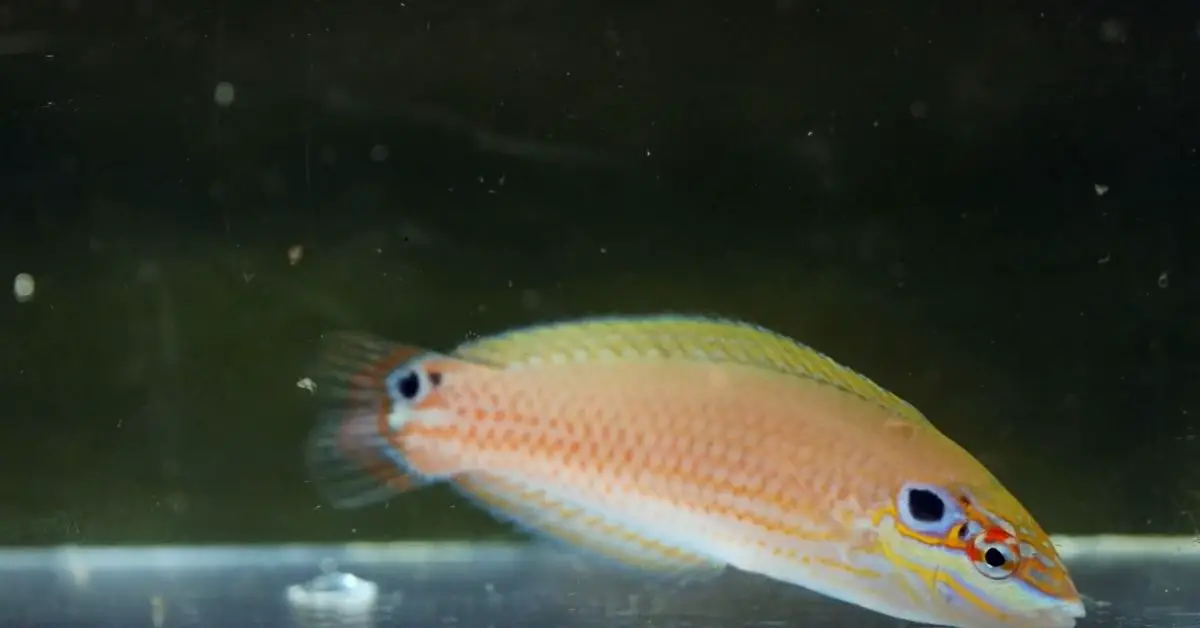The Earmuff Wrasse isn’t a rare fish in the sea, but those who want one as a hobby might say something different. This is because almost everyone with an aquarium wants an Earmuff Wrasse and when the aquarium shops get them in they usually sell out incredibly fast. Only a select few hobbyists are lucky enough to bring one of these unique fish home.
Unlike most Wrasse fish, the Earmuff Wrasse doesn’t have as many dark markings. While their bodies are paler than most wrasse fish, they do have one signature dark marking. The name Earmuff Wrasse comes from the dark spot they have on each side of their heads, which resembles a pair of earmuffs.
The reason that Earmuff Wrasse is so popular is that they are basically the puppy dogs of the sea. Everyone who has had the pleasure of owning one of these fish was amazed at how docile and friendly they were. These happy fish are a wonderful addition to any aquarium. Let’s learn more about how to care for Earmuff Wrasse fish.
Where Are Earmuff Wrasse From?
Earmuff Wrasse can usually be found deeper in the reefs. It’s very rare to find these fish among shallow waters, as they are usually swimming around the rubble and coral. Earmuff Wrasse can be found in many locations, including:
- Rowley Shoals
- Western Australia
- Northern Great Barrier Reef
- Queensland
- Coral Sea
- Christmas Island
- Cocos Island
When searching for Earmuff Wrasse, they are generally located 30 to 150 feet underwater. Many can be found off steep drop-offs, avoiding shallow waters. One of the main reasons they stay close to the bottom of the sea is because this where they can find food and hide from predators.
What Does Earmuff Wrasse Eat?
Earmuff Wrasse has quite a healthy appetite. When they are in the wild, they often feed on crustaceans, snails, and other small creatures found on the bottom of the ocean floor. This is why you can find them swimming around the corals because they are on the lookout for food.
When you bring an Earmuff Wrasse home, their diet is pretty straightforward. They have the same diet as other Halichoeres Wrasse fish and should be fed a hardy diet. The best thing to feed your wrasse fish are bite-sized pieces of seafood, fresh or frozen is acceptable. This includes things like:
- Brine
- Mysid
- Live blackworms
You should also include premium quality flake food or pellet food as well, but they may not be attracted to it right away. When you first bring them home they aren’t accustomed to store-bought food, so they may not have any desire to touch it until they are adjusted in the aquarium.
If they are turned off by the flakes/ pellets at first don’t throw them out. Instead, try feeding it to them again when they are more comfortable with their surroundings.
What Are The Tank Requirements For Earmuff Wrasse?
Earmuff Wrasse fish can actually grow to be slightly larger than other Halichoeres Wrasse fish. The average Earmuff Wrasse can grow to be 10 inches long. This means that they will need a tank suitable for their size to stay happy and healthy. The minimum size requirement for an Earmuff Wrasse tank is 125 gallons.
While these fish are very adaptable, they do hand one requirement. That is a sandbed of at least two inches so they can bury themselves when they feel scared. They also like to bury themselves at night for comfort. Remember, these fish love to swim around rubble and corals, so it’s a good idea to simulate these surroundings in their tank to make them more comfortable.
Tank Mates – Do Earmuff Wrasse Get Along With Other Fish?
Part of the reason Earmuff Wrasse is so popular among fish lovers is that they are so friendly. They get along very well with every type of wrasse fish, becoming friends for life. Actually, they can get along with almost every fish in your tank. This is why they have a reputation for being like puppy dogs. Earmuff Wrasse can make friends with almost anything they meet.
What puts some people on edge is the idea of their shrimp in the same tank as an Earmuff Wrasse. There usually isn’t anything to worry about because these fish don’t bother anyone else in the tank. They may get along with many types of shrimp, without becoming a threat. This includes:
- Pistol Shrimp
- Coral Banded Shrimp
- Blood Shrimp
- Skunk Cleaner Shrimp & more
These fish are generally good for not bothering any coral. However, they may try to eat any crustaceans or small snails in the tank. To avoid this, make sure they are being fed a diet rich in nutrients. If they have all their nutrients, these fish typically mind their business and let the other fish in the aquarium roam without causing a nuisance.
Final Thoughts: What You Need To Know About Earmuff Wrasse?
Everyone loves an Earmuff Wrasse fish. These beautiful fish are not only eye-catching, but they are one of the friendliest types of fish you can get for the tank. No wonder so many people want to bring one home. Everything from their signature ear spots to their docile attitudes makes them an ideal choice for your home aquarium.
The great thing about Earmuff Wrasse is that they can make friends with any other fish or sea creatures you have in the aquarium. Although you will have to stay cautious if you have any snails or crustaceans in the tank.
These fish are quite hardy, so it’s important to make sure they are getting an adequate diet that meets their needs. Although these fish may be slightly larger than your average wrasse fish, they are by no means a bigger threat to anything else in the tank. This is why everyone thinks of them as puppies of the sea.

